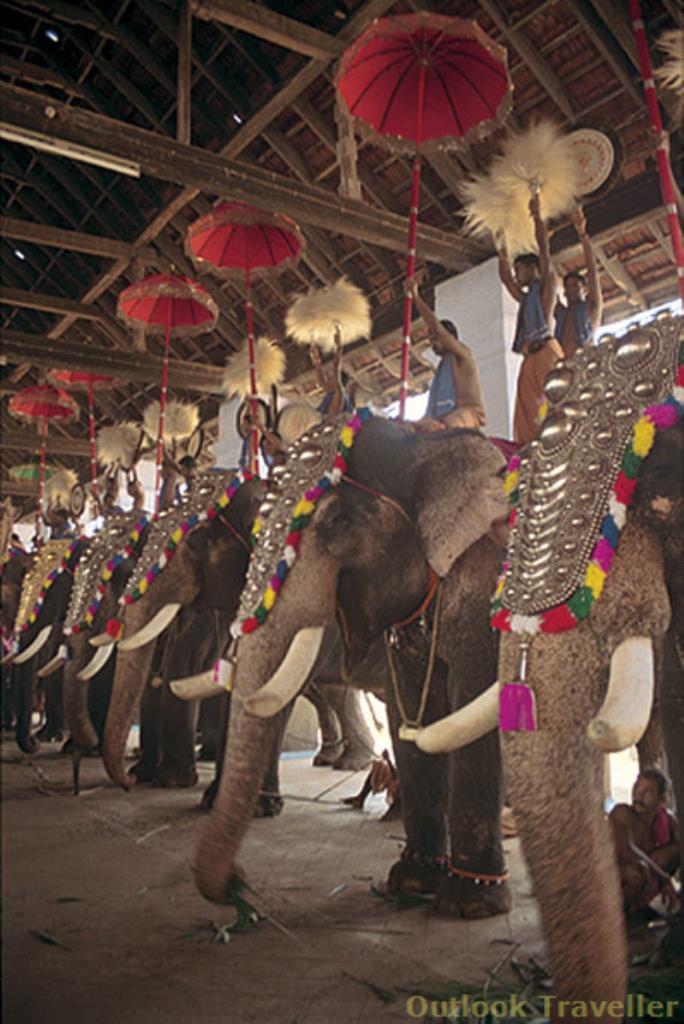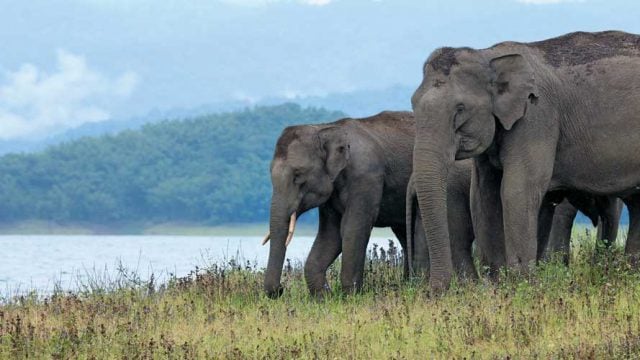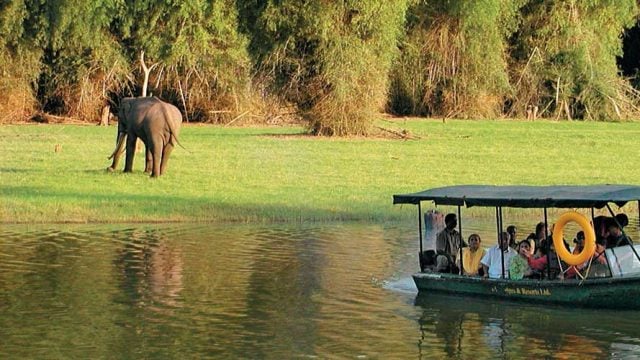How many elephants can you fit into a room? Seventeen, if it is a pavilion
Irinjalakuda. If you are not from the south, better still, from Kerala, it’s unlikely you would have ever wound your tongue around that name. Pity. For, the town’s centrepiece, the ninth-century Koodalmanickam temple, originally a Jain shrine, is among the most enchanting spaces I have ever entered.
It’s not so strange that an agnostic should count a Kerala temple as among his most loved spaces. The most precious quality of the Koodalmanickam — palpable at all times except during the festival — is its emptiness and silence. It is funny how silence sharpens sight. The Kerala temple is almost always a visible embodiment of precision, sweep, stillness and grace. In larger examples, a tall bulging outer wall — aana mathil, literally, ‘elephant wall’ — encloses the even expanse of the temple grounds. The towering roof over the sanctum (srikovil) rises from within another, relatively smaller, inner enclosure (chuttambalam) which also houses facilities for daily rituals.
The Kerala temple is intimate and monumental at the same time because it extends horizontally, rather than vertically. The relatively low roof of the chuttambalam keeps it within reach of an extended limb while the immaculate expanse lets the level gaze traverse an immensity. The Koodalmanickam — possibly the only temple in India dedicated to Rama’s brother, Bharatha — also has two lofty pavilions, the nadapuras, one each to the east and west of the inner enclosure. Soaring beyond an elephant’s height they offer an unexpected counterpoint to the reposeful spread of the temple, especially of its inner enclosure around the sanctum. Every evening during the festival, that chuttambalam wall melts into the dark and a pinpoint matrix of flickering oil lamps wells up almost magically from the void in its place. Its image then floats still upon the surface of the kulipeeni teertham, a ritual pond covering the entire northern third of the temple grounds.
The 10-day Koodalmanickam utsavam starts a day after the day-long Thrissur pooram. The festival develops around the presiding deity’s decision, once every year, to emerge from his sanctum into the outer enclosure of the temple on each of the 10 days. Bharatha (or Sangameswara) even ventures out into the town on two occasions, once for the palliveta (ritual hunt) and on the next and final morning for the arattu, a three-elephant musical procession leading to his purificatory bath to one of two nearby rivers. The palliveta is staged on the ninth evening during which Bharatha is taken in an elephant procession with due pomp to a large banyan tree down the road which symbolises town limits. There, a clever replica of a wild boar made of banana stem is virtually ‘shot’ by the archer king during the three-hour event.
God turns out to be an archer king. And the sacred banyan tree of palliveta fame is next to the main bus station eating up the width of the market road. All through the festival, as in many Indian ritual celebrations, the lines between the sacred and profane, divine and mundane, spiritual and sensual, keep shifting. The vibrant ritual core of the festival is enacted largely within the chuttambalam. Its intensity is manifest as a more popular and democratic choreography of spectacle outside. You sense how the festival churns up the devotional social life of the town, when you see kids playing ball inside the temple grounds. Ordinarily, that expanse is a rare bounded space offering a measured evocation of infinity. There is no lingering in that expanse then, only the quick shimmer of crisp gold-lined saris and the swish of white mundus, during the ritual circumambulation of the inner enclosure. During the festival, however, this space is like Shivaji Park on a Mumbai evening. Men, women, children, old people, day-trippers from nearby towns — and Chandran back from Chennai to reaffirm his roots, like Gopinathan from the Gulf — throng the grounds and the nadapuras where the melam unfolds. And after the first day, the elephants don’t tower so much anymore — they are just the gentle giants watching over the crowd, or being themselves watched as they are bathed and fed ‘offstage’.
The measured frenzy of the melam kicks off the daily round of festivities in the morning. Over a hundred musicians swiftly raise a delectable and pounding clamour as the bedecked elephants look on like stoics in the din, unwilling to raise an eyebrow. At least half the musicians are percussionists, with strong shoulders and supple wrists. The chenda (drum) is heavy, and slung across the torso. But the wrists swing smoothly, even at speed. It is the beat that is hectic, not the curve of stick striking intricate rhythms upon the hide, however many times a second. No wonder, their venerable and diminutive leader — Kuttan Marar, from nearby Peruvanam — is a regional celebrity. Meanwhile, artists on the kurunkuzhal (short pipe) and the kombu (curved trumpet) weave a continuing sparkle — like gold thread woven into the fringe of a white cotton mundu — into the deeply layered thicket of drumbeats.
You are not meant to catch everything at the utsavam. The festivities are a 22/10 affair. The hugely popular melams lasting three to four hours each are offered to Bharatha once in the morning and once at night. After lunch there are traditional folk performances like Ottam Thullal, and Kurathiyattam, and Patakam in the nadapuras. From late afternoon the makeshift thatch auditorium in a corner of the grounds hosts ‘cultural programmes’ including classical music or dance performances, some very good. But one afternoon, I had the bizarre experience of watching a vibrant Ottam Thullal performance — a dramatised but conversational folk form of storytelling — being slowly but successfully drowned by the arrogant blaring of the loudspeaker in the corner auditorium.
The stage-mike-loudspeaker ensemble is the only false note in the protean festivity throughout. It is a shabby frame particularly for the grand but nuanced Kathakali performances every night, which begin after midnight and close around 6am. In spite of the inauspicious ambience, the performances — involving stars and adepts — are often accomplished. It helps if you have left your TV-training behind. Sitting on the ground, you are slowly and steadily absorbed into the night-long performance as it unfolds at a brisk but measured pace, along with a relaxed crowd of two hundred or so, which by morning has dwindled to fifty. Not all who start stay awake, and not all who are awake started at the very beginning. The numbers are different on the final night when Sree Rama Pattabhishekam is performed. I miss the performance, but hear about it later. Enacting the coronation of Rama, as part of the performance the mini-procession including the lead character, moves from the gopuram to the ‘auditorium’ distributing prasadam to the thousands-strong audience along the way. Moved by the evocation of divinity at the uncertain hour of dawn (and possibly, themselves assuming the role of Ayodhya’s blessed), numbers of people fall at ‘Rama’s’ feet for his blessings.
The devotion of other people is a strangely humbling thing to watch, unless one is a confirmed cynic. It is the last morning of the festival and Bharatha — ‘polluted’ after the ritual hunt or palliveta, and therefore having spent the night in the outer enclosure of the temple — is being readied for the arattu, an excursion to the river for his purificatory bath that will effectively close the festival. The lead elephant who will bear the deity to the river is brought to the little doorway in the wall of the inner enclosure. I find myself in a crowd of mothers, grandmothers and frisky children wedged between the wall and the elephant who is only an extended arm away. At a signal from the mahout standing by, the elephant shifts weight, draws back and starts getting down on its knees. As it settles into a moment of homage to the deity, a tremulous shiver of devotion runs through the crowd around me. I am moved but feel strange. Incapable of extreme faith, and slightly envious of capable others, I can’t help wondering: what if the big fellow chokes on one of the balls of rice being tossed into his mouth by the distracted priest?
Twenty minutes later, I am standing outside on the street facing the gopuram, camera at the ready to capture the elephants emerging out into the bustle of the impromptu market. The orchestra has already emerged and the performers have turned around to face the gopuram. I don’t really get it when I first glimpse the shimmering caparison through the gateway moving uncharacteristically fast. Only when the hush is broken with an old man’s cry, “Aana Odi”, does everyone suddenly wake up. The elephant is running. At us. As the crowd makes way, hurriedly falling away and upon itself on either side of the path, the lead elephant thunders past with a wild shriek, the young Namboodiri on top manfully holding on to the bobbing deity. And then another shoots out, and one more, till the three of them are galloping past as if in some race. It is over in seconds. I recover just in time to see them all take a sharp, precise right turn a hundred metres down the road, and zip into an open-air exhibition of home goods. They run clean through, straight into their yard beyond, without a trace of the turmoil left in their wake. Only, the priests are left to repair the collateral damage to faith with extended rituals that eventually push the restart of the arattu to afternoon.
Elephants may get prodded painfully by their mahouts again, they may even take fright at crowds they have been used to for 10 days. But we will probably never see this relay of alarm that quickly became a sprint again. And not just because the Friends of Elephants rightly wrote to the government about possible mistreatment of elephants during festivals. The elephant’s presence, after all, is almost hardwired into the very body of the temple.
My four-year-old who was with mother and granny in the crowd on the sides backing into the toy stalls voices the general sense of relief. Half smiling (and ducking at the shock and thrill of the memory), he says he “was worried that all the toys may go phhishik. But nothing happened.” So it’s all right then, saar ilya.
He is now waiting for the elephants to come back next year.
The information
Getting there: Irinjalakuda is a small town well connected by bus, train and air. It is located 24km south of Thrissur and about 60km north of Kochi. If arriving by air Kochi’s Nedumbassery airport is only about 40km away. Only a few long-distance trains stop in Irinjalakuda; for most trains on Konkan Railway get off at Thrissur. Netravati Express and Mangala Exp connect to Mumbai, and the Rajdhani Express can fetch you from New Delhi.
Where to stay: Irinjalakuda does not have many good hotels. The Kallada Regency is the only three-star hotel (non-AC double Rs 600, AC Rs 900; 0480-2832601).
WHat to see & do:
The Koodalmanickam temple is worth a visit on its own even without the festival, which usually occurs in April or May. Men are allowed into the chuttambalam only if they are bare-chested and wearing a white mundu. Women need to be in saris or skirts. Only Hindus are allowed in.
There are a number of very beautiful temples within an hour’s ride from Irinjalakuda: Vadakkunathan Temple in Thrissur, as well as temples at Peruvanam, Kodungallur, Urakkam and Triprayar. The Koodalmanickam has an exquisite koothambalam (as has the Vadakkunathan at Thrissur), a traditional theatre building, one of the few where traditional Koothu performances are still conducted.
The famous Koodiyattam performer-guru, Ammanur Madhava Chakyar, declared an icon of intangible heritage of the world by UNESCO, lives in Irinjalakuda. His disciple G. Venu, himself an eminent performer-scholar, runs Natanakairali, a vibrant research and training institution devoted to Koodiyattam.
Nadavaramba, a famous centre of bell metal casting, is 15min from Irinjalakuda.
Kaladi, the birthplace of Adi Sankaracharya, is a few hours by road.
Koodalmanickam temple
Irinjalakuda
Kerala
Koodalmanickam temple




